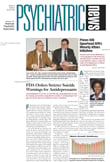The safety of patients with suicidal behaviors is of utmost concern for the clinicians who evaluate and treat them. It is a hard reality that sometimes in the course of treatment a patient commits suicide. A suicide is a devastating event for all involved—the patient’s family, friends and community, the treatment team, and the treating psychiatrist. Also, unfortunately, patient suicide and suicide attempts are the most frequently identifiable cause of lawsuits against psychiatrists.
Improving patient safety for those at risk of suicide is an extremely important goal when the personal, professional, and dollar cost of patient suicide is so high. APA’s Practice Guideline for the Assessment and Treatment of Patients With Suicidal Behaviors, published in a supplement to the November 2003 American Journal of Psychiatry, is an essential and comprehensive tool for improving patient safety and offers recommendations to help psychiatrists assess and treat adult patients with suicidal behaviors.
This brief article focuses on one risk management strategy that has the potential to support patient safety and reduce professional liability exposure. The methodology that has been set out by experts for improving patient safety involves identifying errors, analyzing the causes of preventable errors, and developing better processes and systems to prevent those problems and errors in the future. This is also the description of the risk management process. The five-step risk management process is described below to present the reduction of lethal means and methods of self-harm as a patient-safety measure for patients with suicidal behaviors.
Step 1: Identify current and potential risks
The potential for self-harm by a patient with suicidal behaviors exists throughout his or her evaluation and treatment. The risk that a patient will commit suicide is highest when the patient is most vulnerable and least able to protect himself or herself, for example, at discharge from the hospital. The accessibility of lethal means and methods of self-harm increases the risk of self-destructive behaviors.
Step 2: Evaluate risk (frequency and severity)
Data from the National Center for Health Statistics as of 1998 show that firearms are used in 57 percent of suicides. Other methods are suffocation (18.7 percent), poisoning, including medications (16.6 percent), and falls (2 percent).
Research has shown that increased rates of suicide are linked to the presence and accessibility of a lethal means of self-destruction, and that “40 percent to 50 percent of households have a firearm inside the home,” according to the Department of Health and Human Services (HHS) 2001 report, “National Strategy for Suicide Prevention: Goals and Objectives for Action.”
Since the use of medications has become a centerpiece for psychiatrists in the treatment of mental illness, it is highly likely that patients with suicidal behaviors will be prescribed medication and will have access to potentially lethal medications. They may also have access to medications prescribed for comorbid somatic conditions or to the medications of family members or significant others. The use of alcohol or illegal substances in conjunction with prescribed medications increases lethality.
Suicide is a low-frequency/high-severity event. However, the presence of firearms or stockpiled medication increases the risk of a suicide occurring (frequency). The presence of those means also tends to keep the probable lethality of efforts high (severity). Reducing these risks requires a systematic approach.
Step 3: Choose a risk management strategy
Evidence shows that restricting access to lethal methods of self-harm can be an effective strategy to prevent self-destructive behaviors for some individuals, according to the HHS report. These are some risk management strategies for reducing the risk of the most frequent methods of suicide: firearms and poisoning:
• During evaluation of patients with suicidal behaviors, inquire about suicide plans and whether a method has been considered. Find out about methods used in any prior suicide attempts.
• Inquire whether firearms are available to patients with suicidal behaviors.
• Educate patients and significant others about the risk of accessibility of firearms.
• Instruct patients and significant others about restricting access to firearms and properly securing or removing firearms.
• When prescribing for patients with suicidal behaviors, the decision about type and amount of medication should reflect the extent of your experience with each patient, your knowledge of the patient, the severity of the patient’s suicidality, and the extent to which physician-prescribed medications may be of significance to the patient.
• Communicate with other health care professionals about the medications that are being prescribed by all physicians involved in the patient’s treatment and about concerns related to the patient’s suicide risk.
• Put in place a procedure for safely processing prescription refills. Staff members in your office should know when it is not acceptable to get refill orders routinely for some patients. Refill prescriptions for other psychiatrists’ patients with care. Review such refills with the psychiatrist if possible. Where such review is not possible, consider prescribing only enough medication to cover the patient until the psychiatrist returns or can be consulted.
• Education and instruction about the risk of overdose, etc., should be part of the informed-consent process about medications in all patients, particularly those with suicidal behaviors.
• Document the evaluation of the risk of access to lethal means and methods of self-harm, plans for restricting access, and instruction to patients and significant others.
Step 4: Implement the strategy
Incorporate the evaluation of lethal means and methods of self-harm as a standard part of the assessment and treatment of patients with suicidal behaviors. Take appropriate actions to restrict access to lethal methods.
Step 5: Evaluate the strategy
Incorporate the continuous evaluation and improvement of these strategies for reducing suicide risk for patients in your practice. ▪
